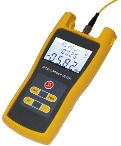-

- Sopto Home
-

- Special Topic
-

- Fiber Optics knowledge
-

- Introduction to Fiber Optics Temperature Measurement
Fiber Optics knowledge
- Maintained Methods of Fusion Splicer Parts
- How to Use the Fiber Optic Cleaver?
- What are Fixed Attenuators & Variable Attenuators?
- Deployable Fiber Optic Systems for Harsh Mining Environments
- Developing Miniature Fiber Optic Cable Has Become the Trend
- Fiber Optic Cleaning Procedures
- 6 Steps to Selecting a Fiber Optic Cable
- Signal Attenuation Introduction
- How Fiber Transmission Works?
SOPTO Special Topic
Certificate



Guarantee
Except products belongs to Bargain Shop section, all products are warranted by SOPTO only to purchasers for resale or for use in business or original equipment manufacturer, against defects in workmanship or materials under normal use (consumables, normal tear and wear excluded) for one year after date of purchase from SOPTO, unless otherwise stated...
Return Policies
Defective products will be accepted for exchange, at our discretion, within 14 days from receipt. Buyer might be requested to return the defective products to SOPTO for verification or authorized service location, as SOPTO designated, shipping costs prepaid. .....
Applications
Fiber Optis can be used in so many fields:
Data Storage Equipment
Interconnects,Networking
Gigabit Ethernet
FTTx, HDTV,CATV
Aerospace & Avionics
Data Transfer Tests
Network Equipment
Broadcast Automotive
Electronics,Sensing
Oil & Gas, Imaging
Outside Plant,Central Office
Harsh Environment
Data Transmission
Illumination,Institutions
Ship to Shore,Education
Simulation,Military,Space
Unmanned Aerial Vehicles
Semiconductor Equipment
Diagnostics & Troubleshooting
Premise Networks Carrier Networks
Independent Telecommunication Providers
SOPTO Products
- Fiber Optic Transceiver Module
- High Speed Cable
- Fiber Optical Cable
- Fiber Optical Patch Cords
- Splitter CWDM DWDM
- PON Solution
- FTTH Box ODF Closure
- PCI-E Network Card
- Network Cables
- Fiber Optical Adapter
- Fiber Optical Attenuator
- Fiber Media Converter
- PDH Multiplexers
- Protocol Converter
- Digital Video Multiplexer
- Fiber Optical Tools
- Compatible
Performance Feature
Fiber Optics knowledge
Recommended


Introduction to Fiber Optics Temperature Measurement
Fiber optics is essentially light pipes. The group of sensors is known as fiber optic thermometers generally refer to those devices measuring higher temperatures wherein blackbody radiation physics are utilized. Lower temperature targets--say from -100°C to 400°C--can be measured by activating various sensing materials such as phosphors, semiconductors or liquid crystals with fiber optic links offering the environmental and remoteness advantages.
Whether used for communications or infrared temperature measurement, fiber optics offers some inherent advantages for measurements in industrial and/or harsh environments:
Unaffected by electromagnetic interference (EMI) from large motors, transformers, welders and the like;
Unaffected by radio frequency interference (RFI) from wireless communications and lightning activity;
Can be positioned in hard-to-reach or view places;
Can be focused to measure small or precise locations;
Does not or will not carry electrical current (ideal for explosive hazard locations);
Fiber cables can be run in existing conduit, cable trays or be strapped onto beams, pipes or conduit (easily installed for expansions or retrofits); and,
Certain cables can handle ambient temperatures to over 300°C--higher with air or water purging.
Fiber optic thermometers have proven invaluable in measuring temperatures in basic metals and glass productions as well as in the initial hot forming processes for such materials. Boiler burner flames and tube temperatures as well as critical turbine areas are typical applications in power generation operations. Rolling lines in steel and other fabricated metal plants also pose harsh conditions which are well handled by fiber optics.
Typical applications include furnaces of all sorts, sintering operations, ovens and kilns. Automated welding, brazing and annealing equipment often generate large electrical fields which can disturb conventional sensors.
High temperature processing operations in cement, refractory and chemical industries often use fiber optic temperature sensing. At somewhat lesser temperatures, plastics processing, paper making and food processing operations are making more use of the technology. Fiber optics are also used in fusion, sputtering, and crystal growth processes in the semiconductor industry.
Beyond direct radiant energy collection or two-color methods, fiber optic glasses can be doped to serve directly as radiation emitters at hot spots so that the fiber optics serves as both the sensor and the media. Westinghouse has developed such an approach for distributed temperature monitoring in nuclear reactors. A similar approach can be used for fire detection around turbines or jet engines. Internal "hot spot" reflecting circuitry has been incorporated to determine the location of the hot area.
An activated temperature measuring system involves a sensing head containing a luminescing phosphor attached at the tip of an optical fiber. A pulsed light source from the instrument package excites the phosphor to luminescence and the decay rate of the luminescence is dependent on the temperature. These methods work well for non-glowing, but hot surfaces below about 400°C.
Sopto supplies high quality fiber optics, like, "Figure 8" Leaper cable, GYTA and so on with reasonable price. For the newest quotes, please contact a Sopto representative by calling 86-755-36946668, or by sending an email to info@sopto.com. For more info, please browse our website.






